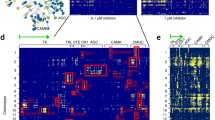Abstract
Despite the hundreds of kinase inhibitors currently in discovery and pre-clinical phases, the number of kinase inhibitors which have been approved and are on the market remains low by comparison. This discrepancy reflects the challenges which accompany the development of kinase inhibitors which are relatively specific and less toxic. Targeting protein kinases with ATP-competitive inhibitors has been the classical approach to inhibiting kinase activity, but the highly conserved nature of the ATP-binding site contributes to poor inhibitor selectivity, issues which have particularly hampered the development of novel kinase inhibitors. We developed a high-throughput screening technology that can discriminate for inhibitors which stabilize the inactive “DFG-out” kinase conformation by binding within an allosteric pocket adjacent to the ATP-binding site. Here, we describe how to use this approach to measure the K d of ligands, as well as how to kinetically characterize the binding and dissociation of ligands to the kinase. We also describe how this technology can be used to rapidly screen small molecule libraries at high throughput.
Access this chapter
Tax calculation will be finalised at checkout
Purchases are for personal use only
Similar content being viewed by others
References
Knight ZA, Lin H, Shokat KM (2010) Targeting the cancer kinome through polypharmacology, Nat Rev Cancer 10: 130–137
Liu Y, Gray NS (2006) Rational design of inhibitors that bind to inactive kinase conformations. Nat Chem Biol 2:358–364
Backes AC, Zech B, Felber B, Klebl B, Müller G (2008) Small-molecule inhibitors binding to protein kinases. Part I: exceptions from the traditional pharmacophore approach of type I inhibition Expert Opin Drug Discovery 3:1409–1425
Backes AC, Zech B, Felber B, Klebl B, Müller G (2008) Small-molecule inhibitors binding to protein kinase. Part II: the novel pharmacophore approach of type II and type III inhibition. Expert Opin Drug Discovery 3:1427–1449
Rabiller M, Getlik M, Kluter S, Richters A, Tuckmantel S, Simard JR, Rauh D (2010) Proteus in the world of proteins: conformational changes in protein kinases. Arch Pharm (Weinheim) 343:193–206
Simard JR, Getlik M, Grutter C, Pawar V, Wulfert S, Rabiller M, Rauh D (2009) Development of a fluorescent-tagged kinase assay system for the detection and characterization of allosteric kinase inhibitors. J Am Chem Soc 131:13286–13296
Simard JR, Kluter S, Grutter C, Getlik M, Rabiller M, Rode HB, Rauh D (2009) A new screening assay for allosteric inhibitors of cSrc, Nat Chem Biol 5: 394–396
Simard JR, Grutter C, Pawar V et al. (2009) High-throughput screening to identify inhibitors which stabilize inactive kinase conformations in p38alpha. J Am Chem Soc 131:18478–18488
Simard JR, Getlik M, Grutter C, Schneider R, Wulfert S, Rauh D (2010) Fluorophore labeling of the glycine-rich loop as a method of identifying inhibitors that bind to active and inactive kinase conformations. J Am Chem Soc 132:4152–4160
de Lorimier RM, Smith JJ, Dwyer MA, et al. (2002) Construction of a fluorescent biosensor family. Protein Sci 11:2655–2675
Pargellis C, Tong L, Churchill L, et al. (2002) Inhibition of p38 MAP kinase by utilizing a novel allosteric binding site. Nat Struct Biol 9: 268–272
Simard JR, Kamp F, Hamilton JA (2007) Acrylodan-labeled intestinal fatty acid-binding protein to measure concentrations of unbound fatty acids. Methods Mol Biol 400:27–43
Author information
Authors and Affiliations
Corresponding author
Editor information
Editors and Affiliations
Rights and permissions
Copyright information
© 2012 Springer Science+Business Media, LLC
About this protocol
Cite this protocol
Simard, J.R., Rauh, D. (2012). Fluorescence Labels in Kinases: A High-Throughput Kinase Binding Assay for the Identification of DFG-Out Binding Ligands. In: Zanders, E. (eds) Chemical Genomics and Proteomics. Methods in Molecular Biology, vol 800. Humana Press. https://doi.org/10.1007/978-1-61779-349-3_8
Download citation
DOI: https://doi.org/10.1007/978-1-61779-349-3_8
Published:
Publisher Name: Humana Press
Print ISBN: 978-1-61779-348-6
Online ISBN: 978-1-61779-349-3
eBook Packages: Springer Protocols




